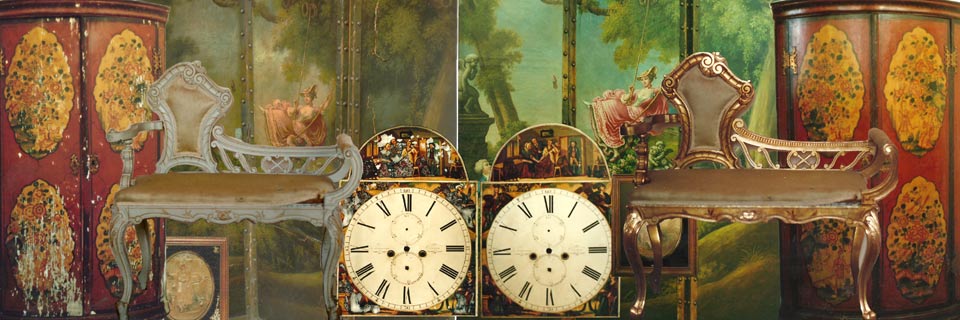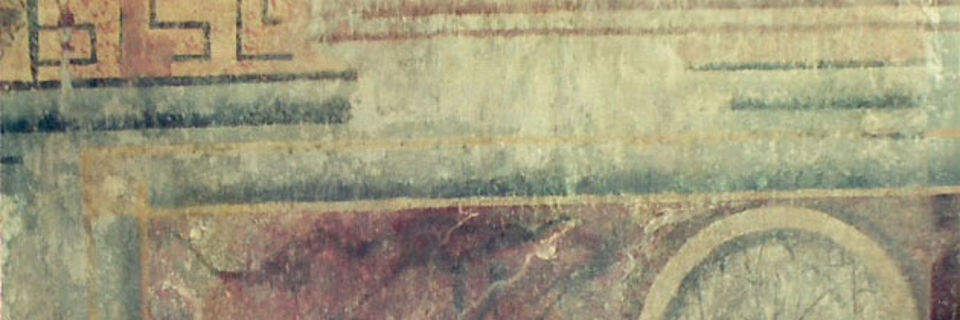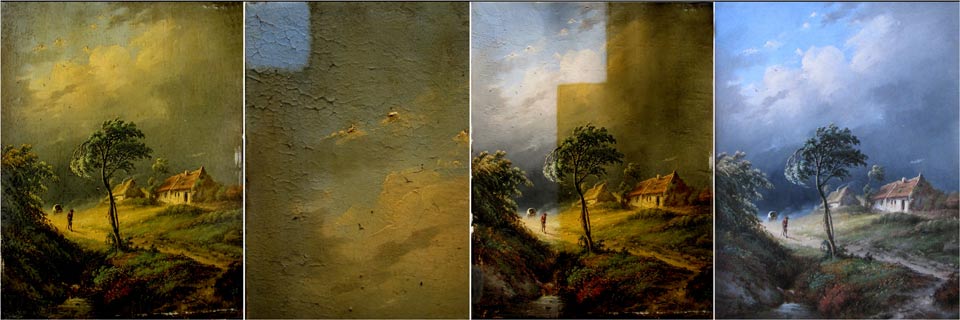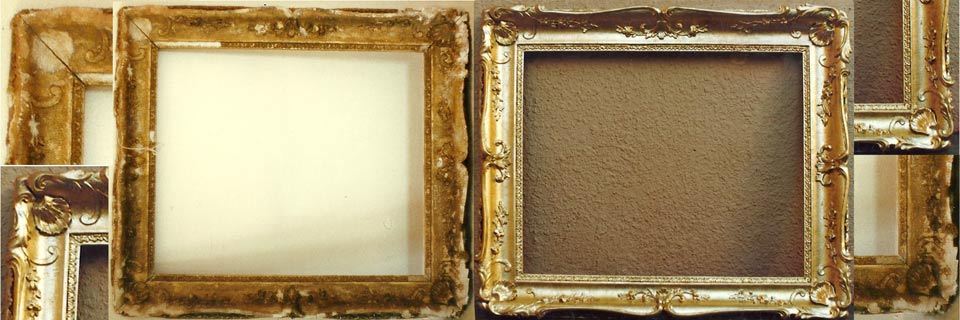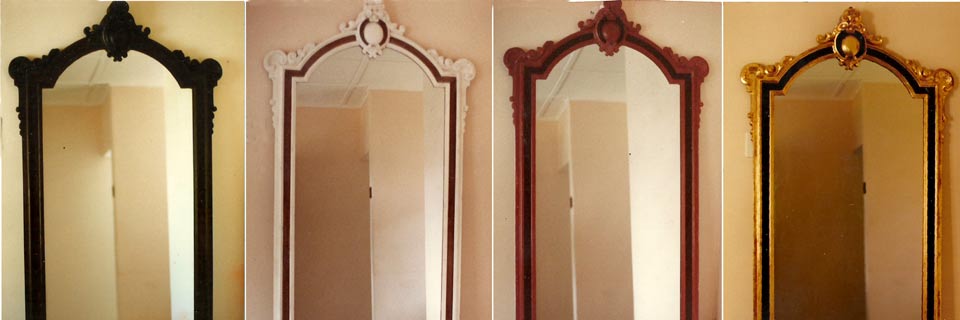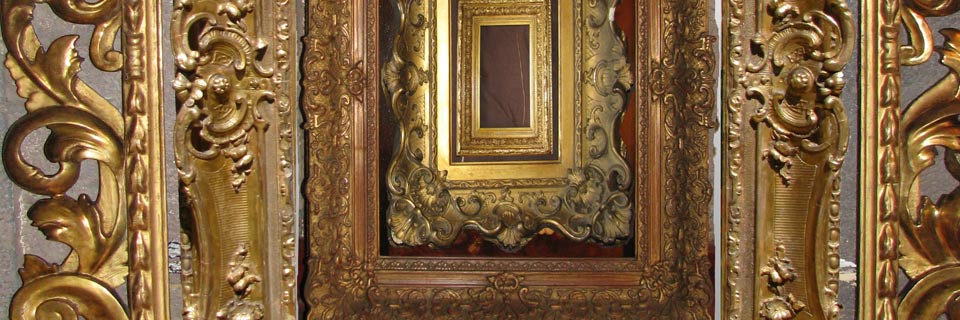Restoration of miniatures, lacquer boxes, tinted screens, painted and gilded furniture, sculptures, inlaid cabinets, papier-mache trays and tables, painted face clocks.
Being a port city and crossroad for many people for more than three centuries, Cape Town sometimes turns up the most incredible finds. Being in business for over 20 years Anastasia Alexander Art Restoration have come across the most amazing objects finding their way to the ends of the earth. Many of these of course had suffered enough on their travels, and needed to be brought back to life. That is why our studio is pleased to offer you professional restoration of the many kinds of objects which follow.
Miniatures
 For many centuries miniatures have been painted on vellum, ivory, enamel, wood or metal, and they provide one of the most challenging types of restoration. Sometimes painting with a brush consisting of only one or two hairs, miniature restoration is a very precise process requiring great patience and immaculate eyes, so every dot that is repaired and touched up has the correct mixture of tones and colours, and blends with the rest as if it had never suffered any damage.
For many centuries miniatures have been painted on vellum, ivory, enamel, wood or metal, and they provide one of the most challenging types of restoration. Sometimes painting with a brush consisting of only one or two hairs, miniature restoration is a very precise process requiring great patience and immaculate eyes, so every dot that is repaired and touched up has the correct mixture of tones and colours, and blends with the rest as if it had never suffered any damage.
Although miniatures are mainly portraits, sometimes one finds miniatures that depict ladies with their dogs, couples strolling in the woods, or other romantic themes which are all pleasing to the eye.
Miniatures may develop mildew on the surface, or may have sustained scratches and cracks, or discolouration with dirt and grime. Anastasia Alexander Art Restoration can address these problems and help you to preserve this link to the past.
Lacquer boxes
 Lacquer is made from the sap of trees related to sumac and poison ivy. It is applied in thin layers, perhaps 100 or more, creating a durable surface. However, over time the natural substance cracks, chips off, or suffers discolouration and bloom. Because they are sometimes painted with gold and inlaid with mother-of-pearl, a lacquer box can be the most intricate of pieces, and not easy to restore.
Lacquer is made from the sap of trees related to sumac and poison ivy. It is applied in thin layers, perhaps 100 or more, creating a durable surface. However, over time the natural substance cracks, chips off, or suffers discolouration and bloom. Because they are sometimes painted with gold and inlaid with mother-of-pearl, a lacquer box can be the most intricate of pieces, and not easy to restore.
Over the years our studio has dealt with a large variety of lacquer boxes from England, China and Japan. Please feel free to call Anastasia Alexander Art Restoration so we can examine these amazing art creations and assist you with any required restoration.
Tinted screens

There is huge variety of tinted screens: fire-screens, room dividers, decorative panels for walls, and so on. They could be painted on cloth, wood, animal skin or even paper. Sometimes they are quite plain but can be quite elaborate, decorated with gold leaf, or even totally gilded with gold leaf.
Improper storage, various forms of mechanical damage, exposure to excessive temperature, excessive humidity or sunlight, all can do a great deal of harm to a precious old object.
Anastasia Alexander Art Restoration would be happy to help you and bring the piece back to its original glory.
Painted and gilded furniture
 The history of painted furniture is as old as organized society. The ancient Egyptians perfected the art of painting and gilding. Objects required for tombs were all the furnishings one owned in life. In addition to the decorated sarcophagus, one's household equipment accompanied the owner into the afterlife. Worldly possessions were seen not only as works of art, but as elegant accessories in the hereafter. Ritual objects and furnishings became part of the immortal existence. The examples indicate a decorating process that has not changed a great deal over time. Wooden pieces were painted with a white undercoat and colour and gilding was applied.
The history of painted furniture is as old as organized society. The ancient Egyptians perfected the art of painting and gilding. Objects required for tombs were all the furnishings one owned in life. In addition to the decorated sarcophagus, one's household equipment accompanied the owner into the afterlife. Worldly possessions were seen not only as works of art, but as elegant accessories in the hereafter. Ritual objects and furnishings became part of the immortal existence. The examples indicate a decorating process that has not changed a great deal over time. Wooden pieces were painted with a white undercoat and colour and gilding was applied.
Artefacts, frescoes and sculptural reliefs all reveal the importance of this art form in the ancient Near East. As Greece and Rome absorbed and redefined artistic expression, decorated furniture retained the importance of previous eras. The middle ages employed the talents of wood carvers, painters and gilders to enhance secular furniture and objects of religious devotion as altars and cathedral interiors became more elaborate.
 As with all art forms, painted furnishings mirrored the societies they decorated. The changes brought by the Renaissance and the exposure to oriental culture, altered European decor. Notable was the introduction of Chinese lacquer. As imitations of this precious material were developed, painted furniture and decor in the 18th century achieved new levels of refinement. Through different eras, design has moved from the curve to the rigid, the fanciful to the severe. Furniture has proved an ideal medium for society to enhance surroundings. Colour and form introduced into our homes can provide pers013-1-230.jpgonal expression and vibrant visual experiences. What began so long ago is now a part of our interior environment.
As with all art forms, painted furnishings mirrored the societies they decorated. The changes brought by the Renaissance and the exposure to oriental culture, altered European decor. Notable was the introduction of Chinese lacquer. As imitations of this precious material were developed, painted furniture and decor in the 18th century achieved new levels of refinement. Through different eras, design has moved from the curve to the rigid, the fanciful to the severe. Furniture has proved an ideal medium for society to enhance surroundings. Colour and form introduced into our homes can provide pers013-1-230.jpgonal expression and vibrant visual experiences. What began so long ago is now a part of our interior environment.
Whatever may be damaged, whether a broken foot, scratched surface or total deterioration of the piece, Anastasia Alexander Art Restoration can repair even the most difficult injury.
Sculptures and figurines

Coming in many shapes and sizes, and made out of many different materials, three-dimensional sculptures often have an uneasy life, finding themselves in the middle and in the way. They fall and break, are stumbled over or dropped, lose their parts and suffer multiple fractures.
Our studio is here for the rescue. Working with wood or plaster, paint or gold, Anastasia Alexander Art Restoration can save your precious piece from its misery.
Papier-mache trays and tables
Literally chewed paper, papier-mache has gained popularity worldwide because of its versatility. Historically it has been made in a wide range of applications, from decorative profiles and mouldings, boats, buildings and furniture. It can also be seen in the colourful products of folk traditions.
 Paper was invented in China in the second century AD, and at about this time began to use papier-mache as a good way to re-use the material which was then expensive and hardly accessible.
Paper was invented in China in the second century AD, and at about this time began to use papier-mache as a good way to re-use the material which was then expensive and hardly accessible.
An important advantage is that it can be very strong but also very light. With strengthening layers of glue and varnish it was even used to make soldiers' helmets. Over time, with the spread of trade, the papier-mache technique was introduced in Samarkand and Morocco and beyond until, in the tenth century, it was known in Spain, Germany, France, Italy, Persia and India.
It was French craftsmen who first recognized the great potential of papier-mache, making cups and snuff boxes and imitating stucco and plaster work. In England a strong development was in moulding and baking either layered sheets or shredded paper to produce a strong board or, with lacquer, products like those made popular in Japan. For building work it was soaked in linseed oil before being baked.

In the later eighteenth century, the production of papier-mache was one of the most important crafts in Central England, with Birmingham as a major centre.Trays, tables, chairs, lamps, book shelves, wall decoration, screens, bed frames were regularly made from papier-mache.The lacquer work was mostly on a black background with patterns of flowers, with gilding and inlay with mother of pearl. In France and Germany papier-mache furniture was very popular. In America one manufacturer made boats. Russia and Scandinavia also developed their own industries.In 1793 in Norway a church, made in papier-mache stood for 37 years.
Large scale production lasted for about a hundred years in Europe but began to decline from about 1870. While mass production has discontinued, there are still million of pieces now need conservation and repair as they became quite valuable historical artefacts.
No matter how bad it is looks when comes to our studio, Anastasia Alexander Art Restoration is capable of solving the problem, whether your papier-mache piece is covered with gold paint, inlaid with nacre (mother-of-pearl) or simply covered with black lacquer.
Painted clock faces

Throughout the history of clocks, families and businesses have used clock faces as canvases. Before the days of digital clocks, such custom-painted items were commonly found in the main rooms of homes and businesses, and often included hand-painted numerals, hemispheres, spandrels (the corners of the clock face), and moon dials.
Since the painting is done mainly on metal surfaces, these artefacts may deteriorate beyond belief, as many tiny particles of paint flake off the tired surface.
Anastasia Alexander Art Restoration will be glad to assist you in solving this kind of problem.











